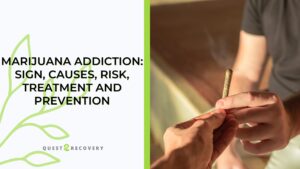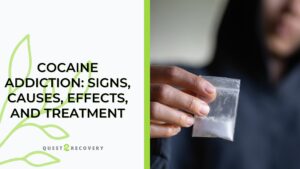Cocaine addiction is a compulsive drug-seeking behavior characterized by an uncontrollable craving for cocaine despite adverse consequences.
Signs of cocaine addiction manifest in various behavioral and physiological changes. Individuals may exhibit increased impulsivity, engaging in risky behaviors without regard for consequences. Physiologically, dilated pupils and a rapid heartbeat are common indicators, along with noticeable weight loss.
Causes of cocaine addiction may include genetic predisposition and environmental factors like trauma or peer pressure. Moreover, the addictive properties of cocaine, which directly affect the brain’s reward system, play a crucial role in the development and perpetuation of addiction.
The effects of cocaine addiction can be severe, leading to physical and mental health issues. Physically, it can cause cardiovascular problems, respiratory issues, and significant weight loss. Mentally, it may result in cognitive impairment, mood disorders, and psychosis. Additionally, the risk of overdose and sudden death rises with prolonged cocaine use.
Treatment for cocaine addiction often combines medical interventions and psychotherapy. Medications can help manage and reduce cravings and withdrawal symptoms, while psychotherapeutic approaches like cognitive-behavioral therapy (CBT) assist individuals in identifying triggers and developing coping mechanisms.
What is Cocaine Addiction?
Cocaine addiction is a complex and chronic condition characterized by the compulsive use of cocaine despite its detrimental consequences. According to Eric J. Nestler, M.D., Ph.D. et al.’s 2005, “The Neurobiology of Cocaine Addiction,” cocaine exerts its psychoactive and addictive effects primarily by targeting the brain’s limbic system, which regulates pleasure and motivation.
Individuals addicted to cocaine often exhibit an intense craving for the drug and disregard the adverse outcomes associated with its use. Psychological addiction is particularly challenging to overcome, as users may prioritize cocaine over other aspects of their lives, ignoring the severe repercussions. Physical dependence also develops with prolonged cocaine use, leading to withdrawal symptoms upon cessation.
Over time, the brain’s reward system becomes rewired due to the heightened levels of dopamine induced by cocaine, making it increasingly difficult for individuals to break free from addiction.
What are the Signs and Symptoms of Cocaine Use?
The signs and symptoms of cocaine addiction encompass behavioral, physical, and psychological aspects. Recognizing these indicators is crucial for early detection and intervention.
1. Behavioral Changes
Individuals grappling with cocaine addiction often undergo noticeable shifts in behavior, including increased impulsivity and mood swings. Cocaine addicts frequently exhibit heightened impulsivity and erratic mood swings. These changes can affect their decision-making processes and interpersonal relationships. Relentless focus on drug acquisition is another behavioral symptom of cocaine addiction. This intense focus may lead to a disregard for personal and social responsibilities.
2. Social Withdrawal
Cocaine addiction frequently prompts individuals to isolate themselves. Cocaine addicts often withdraw from friends and family, prioritizing the drug over meaningful connections. Social withdrawal contributes to deepening feelings of loneliness and alienation. According to Gonzalez, Larry P. et al.’s 1993 article published in NeuroReport, cocaine may also interfere with the body’s ability to cool when exposed to extreme temperatures, in addition to generating more heat.
3. Physical Symptoms
Cocaine use results in physical symptoms like dilated pupils, an accelerated heartbeat, and unexplained weight loss. These serve as common indicators of prolonged cocaine addiction.
4. Psychological Impact
Cocaine addiction can have profound effects on mental health. Individuals may experience heightened paranoia and worsening of pre-existing psychiatric disorders. Persistent paranoia and mood swings can disrupt daily functioning, contributing to social isolation.
5. Financial Strain
Cocaine addiction often leads to financial difficulties. Individuals addicted to cocaine may allocate significant funds to sustain their addiction, neglecting financial responsibilities and creating a substantial financial strain.
6. Risk-Taking Behavior
Cocaine addiction frequently prompts engagement in high-risk activities. People with an addiction may resort to risky behaviors like trading sex or involvement in criminal activities to procure the drug.
What are the Causes and Risk Factors of Cocaine Addiction?
Understanding the complex interplay of causes and risk factors contributing to cocaine addiction involves delving into genetic predispositions and environmental influences.
1. Genetic Vulnerability
The research underscores the role of genetic variations in amplifying susceptibility to the addictive properties of cocaine. Specific individuals may inherit genetic traits that heighten their propensity to develop dependence on the drug.
According to Potenza, Marc et al.’s 2013 article “Biological Contributions to Addictions in Adolescents and Adults: Prevention, Treatment and Policy Implications,” published in the Journal of Adolescent Health, there is evidence suggesting a link between a family history of drug addiction and an increased propensity for cocaine abuse.
Moreover, repeated cocaine use can disrupt the brain’s reward system by triggering excessive release of dopamine, a neurotransmitter associated with pleasure and decision-making. For some individuals, cocaine abuse may serve as a coping mechanism to address inherent deficiencies in neurotransmitter function, leading to shifts in behavior and mood.
2. Environmental Influences
The influence of environmental factors, including exposure to trauma, chronic stress, and peer pressure, cannot be overstated in the development of cocaine addiction. Early life experiences and social contexts significantly shape attitudes and behaviors toward drug use, heightening vulnerability to addiction in later years.
According to Spooner, C. et al.’s 2004 report on the “Social Determinants of Drug Use” from the National Drug and Alcohol Research Centre, peer pressure often motivates individuals to engage in risky behaviors, including cocaine abuse. The pervasive use of cocaine as a party drug further underscores its role in intensifying social experiences and reducing inhibitions in specific social settings.
What are the Effects of Cocaine Addiction?
Cocaine addiction exerts a profound impact on both short-term and long-term health, affecting various aspects of physical, psychological, and social well-being. In the short term, individuals experience euphoria, heightened alertness, and increased heart rate, while long-term use can lead to neurological, cardiovascular, and psychological complications. These effects underscore the urgency of early intervention and comprehensive treatment strategies to address the multifaceted challenges posed by cocaine addiction.
Short-Term Effects
The immediate impact of cocaine use is characterized by short-term effects that manifest shortly after ingestion and typically last for a brief duration. These effects include:
- Cocaine triggers a surge in dopamine levels, leading to euphoria and heightened alertness.
- Short-term cocaine use constricts blood vessels, elevates heart rate, and increases body temperature, contributing to the drug’s stimulating properties.
- Users may experience restlessness, irritability, anxiety, and paranoia during the peak of cocaine’s effects.
Long-Term Effects
Prolonged cocaine use can have profound and lasting effects on both physical and mental health. Long-term effects of cocaine addiction include:
- Chronic cocaine use can lead to structural and functional changes in the brain, resulting in cognitive impairments, mood disorders, and psychosis.
- Cocaine abuse is associated with an increased risk of cardiovascular conditions such as hypertension, arrhythmias, and myocardial infarction due to its vasoconstrictive properties.
- Long-term cocaine addiction can contribute to hallucinations, panic attacks, paranoia, and psychosis, eroding mental well-being and quality of life.
Treatment Approaches for Cocaine Addiction
Cocaine addiction presents a formidable challenge, but effective treatment options exist to address this complex disorder. Treatment approaches for cocaine addiction encompass a multifaceted strategy that combines medical interventions and psychotherapeutic techniques tailored to meet the unique needs of each patient.
Medical Interventions
In treating cocaine addiction, medical interventions play a crucial role in managing cravings and facilitating the recovery process. While there are currently no FDA-approved medications designed to treat cocaine addiction, certain medications have shown promise in alleviating withdrawal symptoms and reducing the risk of relapse. Healthcare providers may prescribe drugs such as disulfiram, naltrexone, and bupropion to help individuals manage their addiction.
Additionally, medically supervised detoxification programs offer a safe and supportive environment for cocaine addicts to undergo withdrawal from cocaine dependence under the close supervision of medical professionals. These programs aim to alleviate discomfort and manage potentially severe withdrawal symptoms while ensuring the safety and well-being of patients.
Psychotherapeutic Approaches
Psychotherapy, particularly cognitive-behavioral therapy (CBT), is a cornerstone of cocaine addiction treatment. CBT helps individuals identify and modify maladaptive thought patterns and behaviors associated with drug use. By exploring the underlying triggers and coping mechanisms, CBT empowers individuals to develop effective strategies for managing cravings and avoiding relapse. Furthermore, client-centered motivational interviewing enhances intrinsic motivation and commitment to change by fostering a supportive and nonjudgmental therapeutic relationship. Through collaborative goal-setting and exploration of ambivalence, motivational interviewing empowers individuals to cultivate a sense of self-efficacy and autonomy in their recovery journey.
How can individuals seek help and intervention for cocaine addiction?
Individuals grappling with cocaine addiction have access to a range of interventions and help techniques designed to address their condition effectively. Early detection and tailored intervention are paramount in mitigating the adverse effects of addiction and facilitating long-term recovery.
1. Screening and Assessment
Screening tools and assessments serve as valuable instruments in identifying individuals at risk of cocaine addiction. By promptly recognizing potential red flags and symptoms, individuals can access treatment services at an early stage, preventing the escalation of addiction.
2. Motivational Interventions
Motivational interventions are pivotal in engaging individuals in treatment and fostering a commitment to change. Through motivational interviewing techniques, therapists help individuals explore their ambivalence towards addiction and instill hope for recovery.
3. Family Therapy
Family therapy offers a supportive environment for individuals struggling with cocaine addiction and their loved ones. Therapy sessions aim to strengthen family bonds and facilitate the healing process for all members involved by addressing familial dynamics and communication patterns.
4. Peer Support Programs
Peer support programs, such as Cocaine Anonymous and Narcotics Anonymous, provide a sense of community and belonging for individuals navigating the challenges of addiction recovery. By sharing experiences and offering mutual support, peers empower each other to stay committed to sobriety and lead fulfilling lives.
Cocaine Addiction Recovery and Aftercare
Recovery from cocaine addiction is a journey that requires ongoing commitment and support. Beyond initial treatment, individuals must actively engage in relapse prevention strategies and embrace a holistic approach to recovery.
1. Identifying Triggers
Understanding personal triggers and high-risk situations is crucial to maintaining sobriety. By identifying triggers such as stress, interpersonal conflicts, or environmental cues, individuals can develop effective coping strategies to manage cravings and avoid relapse.
2. Developing Coping Skills
Coping skills are essential tools for navigating the challenges of recovery. Through therapy and counseling, individuals learn adaptive coping mechanisms to deal with cravings, stressors, and emotional triggers without resorting to substance use.
3. Establishing a Support Network
Building a robust support network is instrumental in sustaining long-term recovery. Whether through peer groups, individual therapy, or community resources, individuals benefit from having a reliable support system that offers encouragement, understanding, and accountability.
4. Aftercare Programs
Aftercare programs provide a continuum of care for individuals transitioning from formal treatment to independent living. These programs offer ongoing support, counseling, and resources to help individuals navigate the complexities of post-treatment recovery and integrate into society.
What role do environmental influences play in the development of addiction?
Environmental factors such as trauma, stress, and peer pressure contribute to the development of addiction and substance abuse.
What are the common signs of cocaine addiction?
Common signs include changes in behavior, social withdrawal, and physiological symptoms such as dilated pupils and weight loss.
Are there genetic factors that contribute to cocaine addiction?
Yes, genetic predisposition plays a significant role in predisposing individuals to cocaine addiction.
How effective is cognitive-behavioral therapy (CBT) in treating cocaine addiction?
CBT is highly effective in helping individuals identify triggers, develop coping strategies, and sustain long-term recovery from cocaine addiction.









